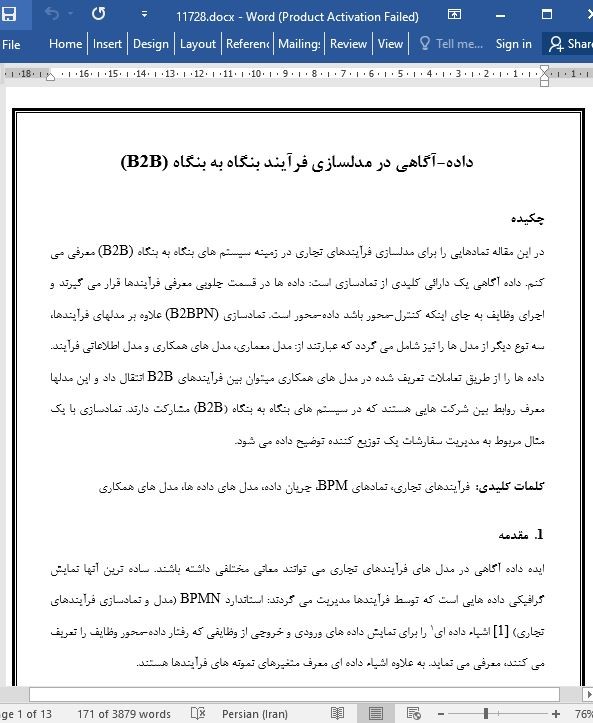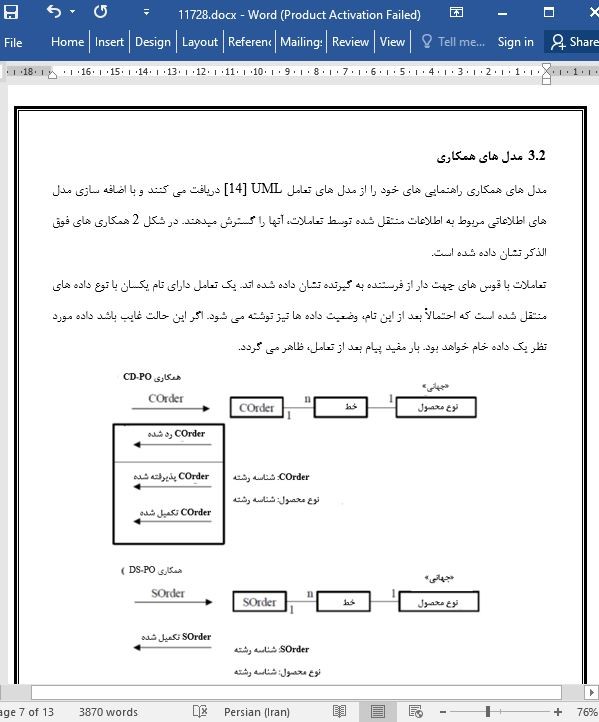
داده-آگاهی در مدلسازی فرآیند بنگاه به بنگاه (B2B)
چکیده
در این مقاله نمادهایی را برای مدلسازی فرآیندهای تجاری در زمینه سیستم های بنگاه به بنگاه (B2B) معرفی می کنم. داده آگاهی یک دارائی کلیدی از نمادسازی است: داده ها در قسمت جلویی معرفی فرآیندها قرار می گیرند و اجرای وظایف به جای اینکه کنترل-محور باشد داده-محور است. نمادسازی (B2BPN) علاوه بر مدلهای فرآیندها، سه نوع دیگر از مدل ها را نیز شامل می گردد که عبارتند از: مدل معماری، مدل های همکاری و مدل اطلاعاتی فرآیند. داده ها را از طریق تعاملات تعریف شده در مدل های همکاری میتوان بین فرآیندهای B2B انتقال داد و این مدلها معرف روابط بین شرکت هایی هستند که در سیستم های بنگاه به بنگاه (B2B) مشارکت دارند. نمادسازی با یک مثال مربوط به مدیریت سفارشات یک توزیع کننده توضیح داده می شود.
1. مقدمه
ایده داده آگاهی در مدل های فرآیندهای تجاری می توانند معانی مختلفی داشته باشند. ساده ترین آنها نمایش گرافیکی داده هایی است که توسط فرآیندها مدیریت می گردند: استاندارد BPMN (مدل و نمادسازی فرآیندهای تجاری) [1] اشیاء داده ای را برای نمایش داده های ورودی و خروجی از وظایفی که رفتار داده-محور وظایف را تعریف می کنند، معرفی می نماید. به علاوه اشیاء داده ای معرف متغیرهای نمونه های فرآیندها هستند.
مفهوم نمونه فرآیندها برای مدیریت یک داده منفرد و هر گونه داده مکمل دیگر مناسب است: فرض مبنا این است که هیچ تداخلی بین نمونه ها وجود ندارد.
4. نتیجه گیری
در این مقاله یک نمادسازی را برای مدلسازی فرآیندها در زمینه سیستم های بنگاه به بنگاه (B2B) معرفی کرده ام. این نمادسازی (B2BPN) علاوه بر مدلهای فرآیند، سه نوع دیگر از مدل (یعنی مدل معماری، مدل های همکاری و مدل اطلاعات فرآیند) را نیز شامل می گردد.
ویژگی های اصلی مدل فرآیند به شرح رو به رو هستند: جریان داده و وظایف، عناصر اصلی هستند، فرآیند منفرد است (فقط یک نمونه وجود دارد) و این سبب انعطاف پذیری زیادی برای ایجاد و تجزیه جریان داده ها با استفاده از وظایف اتصالات، انشعابات، اتصالات/انشعابات، و کاهش می گردد. این نمادسازی همچنین از انتخاب وظیفه ها و واحدهای ورودی پشتیبانی میکند. انتخاب یک وظیفه زمانی رخ میدهد که گروهی از وظایف با ورودی های مشترک وجود دارند: این انتخاب می تواند اتوماتیک باشد و یا ممکن است نتیجه تصمیم شرکت کننده مسئول انتخاب باشد. زمانی که تطابق واحدهای گرفته شده از ورودی ها لازم می باشد، انتخاب واحدهای ورودی با وظایف مشترک (که دو یا چند ورودی دارند) رخ میدهد.
Abstract
This paper presents a notation to model business processes in the context of B2B (Business to Business) systems. Data-awareness is a key asset of the notation: data is placed at the forefront of process representations and task execution is data-driven instead of control-driven. In addition to process models, the notation (B2BPN) includes three other types of models, i.e. the architectural model, the collaboration models and the information model of the process. Data can transit between B2B processes through the interactions defined in the collaboration models and such models represent the relationships between the companies taking part in B2B systems. The notation is illustrated with an example concerning the order management of a distributor.
1. Introduction
The notion of data-awareness in business process models can take on various meanings. The simplest is the graphical representation of the data handled by processes: the BPMN (Business Process Model & Notation) standard [1] offers data objects to represent the input and output data of tasks but without precisely defining a data-driven behavior of the tasks. Moreover, data objects are representations of the variables of process instances.
The notion of process instance is suitable for handling a single data and any other complementary data: the underlying assumption is that there is no interference between instances.
4. Conclusion
This paper has presented a notation to model business processes in the context of B2B systems. In addition to process models, the notation (B2BPN) includes three other types of models, i.e. the architectural model, the collaboration models and the information model of the process.
The major features of the process model are as follows. The dataflow and the tasks are the main elements, the process is singleton (there is only one instance) and this gives great flexibility to compose and decompose data flows by means of join, fork, join/fork, and reduction tasks. In addition, the notation supports choices of tasks and of input entities. The choice of a task takes place when there is a group of tasks having inputs in common: the choice may be automatic or may be the outcome of the decision of the participant in charge of the choice. The choice of the input entities takes place with join tasks (which have two or more inputs) when a match of the entities taken from the inputs is required.
چکیده
1. مقدمه
2. مطالعات مرتبط
3. ویژگی B2BPN
3.1 مدل معماری
3.2 مدل های همکاری
3.3 مدل اطلاعات فرآیندها
3.4 مدل فرآیند بنگاه به بنگاه (B2B)
4. نتیجه گیری
Abstract
1. Introduction
2. Related work
3. The feature of B2BPN
3.1. Architectural model
3.2. Collaboration models
3.3. Process Information model
3.4. B2B Process model
4. Conclusion
References
- اصل مقاله انگلیسی با فرمت ورد (word) با قابلیت ویرایش
- ترجمه فارسی مقاله با فرمت ورد (word) با قابلیت ویرایش، بدون آرم سایت ای ترجمه
- ترجمه فارسی مقاله با فرمت pdf، بدون آرم سایت ای ترجمه



